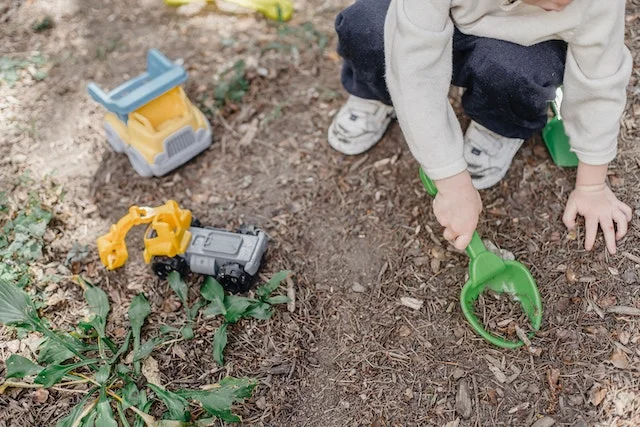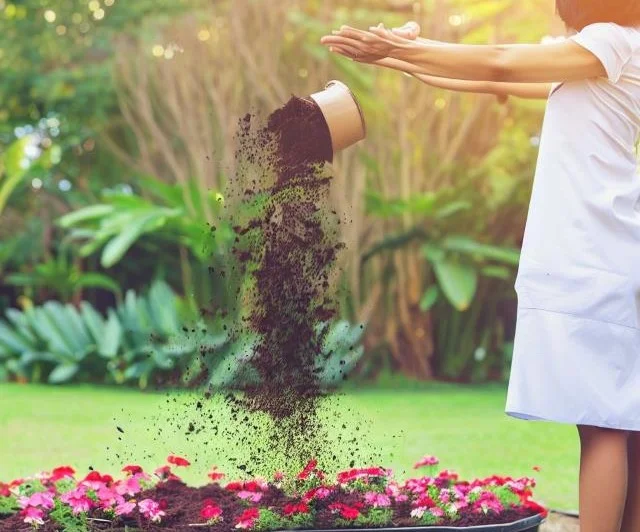What Plants Like Coffee Grounds: Boost Growth and Enrich Soil
Coffee grounds can be a valuable resource for gardeners looking to enhance the growth and health of their plants. While not all plants thrive on coffee grounds, there are specific plants that benefit from their use.
What Plants Like Coffee Grounds Key Takeaways
- Using coffee grounds as fertilizer can boost the growth and health of specific plants
- Coffee grounds enrich the soil by providing essential nutrients and trace minerals
- Plants such as vegetables, fruiting plants, and indoor house plants thrive with the use of coffee grounds
- Composting, making coffee grounds tea, and using coffee grounds as mulch are effective ways of using coffee grounds in gardening
- Caffeine in coffee grounds and the phytotoxicity of fresh coffee grounds can have negative impacts, so moderation is key
Understanding Coffee Grounds and Their Benefits for Plants

Coffee grounds are more than just a byproduct of your morning brew. They can be a valuable resource for gardeners looking to boost the growth and health of their plants. So, what exactly are coffee grounds and how do they benefit plants?
Coffee grounds are the leftover residue from brewing coffee. They contain a range of nutrients and minerals that can benefit plants when used properly. One of the key nutrients found in coffee grounds is nitrogen, which is an essential element for plant growth. Nitrogen promotes lush, green foliage and helps in the production of proteins and enzymes. Coffee grounds also contain trace minerals such as copper, calcium, iron, and zinc, which are important for various plant processes.
When used as a natural soil amendment, coffee grounds can improve the structure and fertility of the soil. They help to break up compacted soil, allowing for better aeration and water drainage. Coffee grounds also enhance water retention in the soil, reducing the need for frequent watering. Moreover, they can bind and neutralize chemical residues in the soil, making them a natural detoxifier.
| Nutrient | Amount in Coffee Grounds |
| Nitrogen (N) | 2.28% |
| Phosphorus (P) | 0.06% |
| Potassium (K) | 0.6% |
| Magnesium (Mg) | 0.24% |
Composting with Coffee Grounds
One popular way to utilize coffee grounds in gardening is by incorporating them into your compost pile. Coffee grounds are considered “green” compost material, meaning they are high in nitrogen. However, due to their high nitrogen content, it’s important to balance coffee grounds with “brown” compost material, such as dry leaves or straw, to maintain a proper carbon-to-nitrogen ratio. Aim to add coffee grounds in moderation, as they can be acidic, and only make up 10-20% of your overall compost mix.
Improving Soil Structure with Coffee Grounds
Adding coffee grounds directly to the soil can improve its structure, particularly for clay soils. The organic matter in coffee grounds helps to break up compacted soil, allowing for better drainage and root penetration. It also encourages the growth of beneficial soil organisms, such as earthworms, which aid in creating healthy soil structure.
Coffee Grounds as a Natural Soil Amendment
As mentioned earlier, coffee grounds can bind and neutralize chemical residues in the soil. This makes them a natural soil amendment, especially in urban areas where soil contamination may be a concern. By using coffee grounds in your garden, you can help detoxify the soil and create a healthier environment for your plants to thrive.
Plants That Thrive With Coffee Grounds

Not all plants are compatible with coffee grounds, but there are specific types that thrive when coffee grounds are used in gardening practices. These plants have different preferences and requirements, and coffee grounds can provide the nutrients and conditions they need to grow and flourish.
Vegetables that like coffee grounds: Carrots, eggplants, potatoes, parsley, peppers, and radishes are among the vegetables that benefit from the nitrogen and trace minerals found in coffee grounds. These nutrients support healthy growth and can improve the yield and quality of the vegetables.
Fruiting plants that benefit from coffee grounds: Fruiting plants such as blueberries, strawberries, avocado trees, citrus trees, mango trees, and pineapples absorb the nitrogen and potassium in coffee grounds, which can promote improved fruit production. Adding coffee grounds to the soil can enhance the overall health and yield of these plants.
Indoor plants that enjoy coffee grounds: Certain indoor house plants also benefit from coffee grounds. African violets, Christmas cactus, jade plants, peace lilies, and snake plants are among the indoor plants that thrive when coffee grounds are used. These plants can absorb the nutrients in coffee grounds, supporting their growth and overall vitality.
Plants that prefer acidic soil: Some plants thrive in acidic soil conditions, and coffee grounds can help create the ideal pH level for their growth. Azaleas, camellias, gardenias, hydrangeas, miniature roses, and rhododendrons are examples of plants that prefer acidic soil, and coffee grounds can provide the necessary acidity for them to thrive.
Table: Plants That Thrive With Coffee Grounds
| Plant Type | Examples |
| Vegetables | Carrots, eggplants, potatoes, parsley, peppers, radishes |
| Fruiting plants | Blueberries, strawberries, avocado trees, citrus trees, mango trees, pineapples, tomatoes |
| Indoor plants | African violets, Christmas cactus, jade plants, peace lilies, snake plants |
| Plants preferring acidic soil | Azaleas, camellias, gardenias, hydrangeas, miniature roses, rhododendrons |
By incorporating coffee grounds into your gardening practices, you can provide these plants with the nutrients and conditions they need to thrive. Remember to use coffee grounds in moderation and consider the specific needs of each plant to ensure optimal results.
How to Use Coffee Grounds for Plants
Now that we’ve explored the benefits of coffee grounds for plants, let’s discuss some practical ways to incorporate them into your gardening practices. From composting to pest control, coffee grounds offer a range of uses that can help your plants thrive.
Composting Coffee Grounds
When incorporating coffee grounds into your compost, remember to mix them with “brown” materials, such as dry leaves or straw, to achieve the proper carbon-to-nitrogen ratio. Aim for a ratio of approximately 25 parts carbon to 1 part nitrogen for optimal composting. Regularly turning your compost pile will help ensure the coffee grounds are evenly distributed and contribute to the overall nutrient content of the compost.
Making Coffee Grounds Tea
Coffee grounds can also be used to make a nutrient-rich liquid fertilizer, commonly known as coffee grounds tea. To make coffee grounds tea, simply place used coffee grounds in a bucket or container and add water. Let the mixture steep for a few days, stirring occasionally. The resulting liquid can be diluted with water and used to water your plants, providing them with an instant nutrient boost. It’s important to note that coffee grounds tea should be used in moderation as a supplement to regular watering, as excessive use can lead to nutrient imbalances in the soil.
Using Coffee Grounds as Mulch
Another effective way to use coffee grounds in your garden is as mulch. Coffee grounds can help suppress weed growth and retain moisture in the soil, reducing the need for frequent watering. Apply a layer of coffee grounds around the base of your plants, being careful not to pile them up against the stems or trunks, as this can lead to moisture buildup and potential rot. Over time, the coffee grounds will break down, adding organic matter to the soil and enriching it with nutrients. Remember to replenish the mulch as needed, especially after heavy rainfall or as the coffee grounds decompose.
Controlling Pests, Detering Cats, and Preventing Weeds
Coffee grounds can also serve as a natural method for pest control in your garden. They can help deter pests like slugs and snails, as they are repelled by the texture and/or the caffeine content in the coffee grounds. Simply sprinkle a layer of coffee grounds around the plants you want to protect. Additionally, coffee grounds have been known to deter cats from entering your garden, as they dislike the smell. To prevent weed growth, you can use coffee grounds as a top dressing in areas where weeds tend to sprout. The coffee grounds will help smother the weed seeds and prevent their germination.
Remember, while coffee grounds can offer many benefits to your plants, moderation is key. Use coffee grounds in appropriate quantities and consider the specific needs of your plants. By incorporating coffee grounds into your gardening practices, you can promote healthier growth, enhance soil fertility, and enjoy a thriving garden.
Potential Issues with Coffee Grounds
While coffee grounds can provide numerous benefits to plants, it is important to be aware of potential issues that may arise from their use. Understanding these concerns can help gardeners make informed decisions about incorporating coffee grounds into their gardening practices.
Caffeine’s Impact on Plant Growth
One of the potential issues with coffee grounds is the presence of caffeine. While caffeine can provide a stimulating effect for humans, it can actually have a negative impact on plant growth. Excessive amounts of caffeine in the soil can hinder the germination of seeds and inhibit the growth of young plants. It is important to use coffee grounds in moderation to avoid the negative effects of caffeine on plant development.
Phytotoxicity of Fresh Coffee Grounds

Another concern when using coffee grounds is their phytotoxicity, particularly when they are fresh. Fresh coffee grounds can release chemicals that may inhibit the growth of certain plants. It is recommended to allow coffee grounds to decompose before applying them to the soil or incorporating them into compost. This gives time for the harmful compounds to break down and reduces the risk of phytotoxicity.
Soil Composition and Microbe Disruption
Applying excessive amounts of coffee grounds can also disrupt the composition of the soil. Coffee grounds are acidic in nature, and too much acidity can alter the pH balance of the soil. Some plants have specific pH requirements, and an imbalance in soil pH can negatively affect their growth. Additionally, coffee grounds contain antimicrobial properties that can potentially harm beneficial microbes in the soil. It is important to use coffee grounds in moderation to avoid disrupting the balance of the soil ecosystem.
| Potential Issues | Impact |
| Caffeine’s Impact on Plant Growth | Can inhibit seed germination and young plant growth |
| Phytotoxicity of Fresh Coffee Grounds | Chemicals released by fresh coffee grounds can inhibit plant growth |
| Soil Composition and Microbe Disruption | Excessive coffee grounds can alter soil pH and disrupt beneficial microbes |
By being mindful of these potential issues, gardeners can navigate the use of coffee grounds effectively and ensure the health and growth of their plants. Moderation is key when incorporating coffee grounds into gardening practices, allowing for the benefits to be maximized while minimizing any potential drawbacks.
Final Thoughts
Using coffee grounds in the garden can have numerous benefits for your plants, but it’s important to remember the key principle of moderation. Maximizing the benefits of coffee grounds involves using them appropriately and in the right quantities for your specific plants.
One effective way to harness the power of coffee grounds is through composting. By adding coffee grounds to your compost pile, you can create nutrient-rich soil that promotes healthy plant growth. Just be sure to limit coffee grounds to no more than 20-35% of the total volume to maintain a balanced compost mixture.
Another way to utilize coffee grounds is by making coffee grounds tea. This liquid fertilizer can be directly applied to plants, providing a quick nutrient boost. Simply steep the coffee grounds in water for a few hours or overnight, strain the liquid, and apply it to your plants. This method is especially beneficial for seedlings or plants in need of a quick pick-me-up.
Remember that coffee grounds can also serve as mulch, offering weed suppression and moisture retention benefits. Additionally, they can be used to control pests such as slugs and even deter cats from entering your garden.
Importance of Moderation in Using Coffee Grounds

While coffee grounds are a valuable resource, it’s crucial to use them in moderation to avoid potential issues. Applying too much coffee grounds can lead to caffeine suppression, which may inhibit plant growth. Fresh coffee grounds, if used excessively, can have phytotoxic effects, hindering the growth of seedlings and young plants.
It’s essential to strike a balance and consider the specific needs of your plants. Use coffee grounds responsibly, keeping in mind that they are just one component of a holistic approach to gardening. By using coffee grounds in moderation and understanding your plants’ requirements, you can optimize their growth and overall health.
| Benefits of Using Coffee Grounds in the Garden | Importance of Moderation in Using Coffee Grounds |
| Enhances soil fertility and structure | Avoids caffeine suppression and phytotoxicity |
| Provides essential nutrients and trace minerals | Maintains a balanced growth environment |
| Improves water retention in the soil | Preserves beneficial soil microbes |
| Assists in weed suppression | Promotes healthy seedlings and plant growth |
By following the principles of moderation and understanding how to maximize the benefits of coffee grounds, you can unlock the full potential of these natural resources in your garden. Remember, a balanced approach ensures the health and vitality of your plants, while minimizing any potential drawbacks.
More Posts to Read
If you want to dive deeper into the world of using coffee grounds in your garden, here are some related posts that you can explore:
1. Coffee Grounds in the Garden
In this post, you’ll discover the various ways coffee grounds can benefit your garden. Learn about their role in improving soil fertility, enriching compost, and enhancing plant growth. Find out how to effectively incorporate coffee grounds into your gardening practices for optimal results.
2. Composting with Coffee Grounds
Composting with coffee grounds is an eco-friendly way to recycle waste and create nutrient-rich soil. This post will guide you through the process of composting coffee grounds, providing tips on compost bin setup, layering techniques, and how to avoid common pitfalls. Discover how coffee grounds can contribute to sustainable gardening practices.
By delving into these posts, you can expand your knowledge and further optimize your gardening practices. Whether you’re interested in the overall benefits of coffee grounds, composting, mulching, or plant nutrition, these resources will provide valuable insights and practical tips for incorporating coffee grounds into your garden routine.
Conclusion
Coffee grounds can be an excellent addition to your gardening routine, providing numerous benefits to your plants. Understanding which plants like coffee grounds and how to use them effectively in gardening practices can enhance the growth and health of your garden. By incorporating coffee grounds into compost, making coffee grounds tea, using them as mulch, and controlling pests, you can maximize the benefits they offer.
However, it is important to use coffee grounds in moderation and consider the specific needs of your plants. Excessive use of coffee grounds or applying fresh grounds can have adverse effects on plant growth and soil composition. It is crucial to strike a balance and ensure that you are not overloading your garden with coffee grounds.
Overall, coffee grounds are a natural and sustainable way to enrich your soil, provide essential nutrients, and promote plant growth. By responsibly using coffee grounds in your gardening practices, you can enjoy the benefits they offer and create a thriving and healthy garden.
What Plants Like Coffee Grounds FAQs
Coffee grounds boost soil fertility, provide key nutrients like nitrogen and potassium, and improve soil moisture retention and aeration. They also make excellent compost and mulch.
Use coffee grounds in moderation – no more than 10-20% of your compost pile. Limit to a thin 1-2 inch layer when using directly in soil. Start small and increase slowly.
Mix into compost pile, brew into liquid fertilizer, or sprinkle dry as mulch around plants.
Vegetables, fruiting plants like blueberries, and acid-loving flowers such as azaleas thrive with coffee grounds.
Excessive amounts can inhibit seed germination and damage young plants due to too much caffeine and acidity. Compost fresh grounds before using them directly on edible plants.








